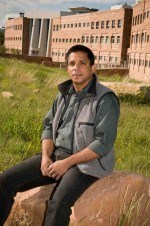Under the sweltering heat of one of the hottest days in San Juan County this year, a crowd gathered to learn what they can do to diminish global warming and its impacts on water systems.
“There is no doubt temperatures have shifted, and they are predicted to rise another 2–5.5 degrees Fahrenheit by mid-century,” said Roger Pulwarty, National Oceanic and Atmospheric Administration’s director of National Integrated Drought Information System.
The free event on Aug. 25, “Drought and Water in the San Juan Islands,” at Brickworks, was cosponsored by the San Juan Conservation District and the San Juan Island National Park Service, Islands Climate Resilience, and the Madrona Institute, to help the community think about conserving water as it becomes an increasingly limited resource.
“Farmers are telling us everything is really dry,” said Linda Lyshell, executive director of the San Juan Conservation District. “What we are actually seeing is that we never recovered from last year’s drought. We are now having a drought within a drought.”
Foreseeing the current drought situation as just the tip of the iceberg, Lyshell has been working with San Juan County’s Water Resource Management Committee to come up with a drought conservation plan in order to mitigate water shortages. Refraining from watering lawns, and planting native, drought-hardy plants are just a couple of things individuals can do to help, according to Lyshell.
The San Juans rely heavily on precipitation, said Lyshell, since there are no mountains on the islands with melting snow packs. Compounding the issue is that aquifers throughout the San Juans tend to be fairly shallow. She stressed that fresh water in the islands is a primary environmental concern right now, and that there are communities on Lopez and San Juan Island that would not exist without desalinization plants.
Pulwarty specializes in water resources, energy, agriculture, ecosystems and disaster management. His research has led him to become cochairman of the White House Task Force on Water, Energy and Food Security. He also works with the International Panel on Climate Change. His talk focused on the world-wide issues of drought.
“We need to connect what we know to what we do,” said Pulwarty, explaining that what scientists know is that global temperatures are expected to rise causing freshwater shortages, among other impacts.
“What people need to do is get creative,” Pulwarty said. “We do need to re-think and re-imagine how we use water.”
He added that human beings are still putting up barriers before acting on climate issues.
Those barriers include scientific uncertainties, the rate of change and economic concerns. Science has had trouble keeping up with the rate of change.
“There is no new normal,” Pulwarty said, which, he added, makes people doubt that changing weather patterns are a threat. Balancing economic needs with environmental needs also creates a barrier. People often feel it is too costly to make needed technological changes. Pulwarty pointed out that refrigerators once pumped out green house gasses, and people did not think there was another way. Now refrigerators are more environmentally friendly and cost -efficient, a win-win for everyone.
“So we should ask ourselves, how much of (the economic barrier) is real?” Pulwarty said.
In looking to the future, Pulwarty gave examples of how human beings are adapting to conserve water around the world. People in the Caribbean have developed water conservation techniques as increased tourism has doubled water consumption. Their systems include rainwater harvesting, desalination plants, efficient sewage treatment systems and renewable energy. Seeing the outcome of human ingenuity and teamwork has given Pulwarty a cautiously optimistic outlook.
“There are surprises in store,” he warned. “We don’t know everything, so we should not be overconfident.” But he said he believes there are ways humans can adapt, and mitigate climate issues, stating that “we need to connect what we know to what we do.”
During the question and answer period, one audience member brought up that cutting vegetation, especially along riparian zones (wetland areas), has not done the climate any favors.
“Plants cool water temperatures and put moisture back into the atmosphere,” the audience member commented. “It seems like replanting could be an easy solution.” Pulwarty nodded in agreement, adding that re-vegetating previously clear-cut areas has helped restore rivers and salmon habitat.
“We are getting somewhere,” Pulwarty said. “Are we getting there fast enough? I don’t know.”



